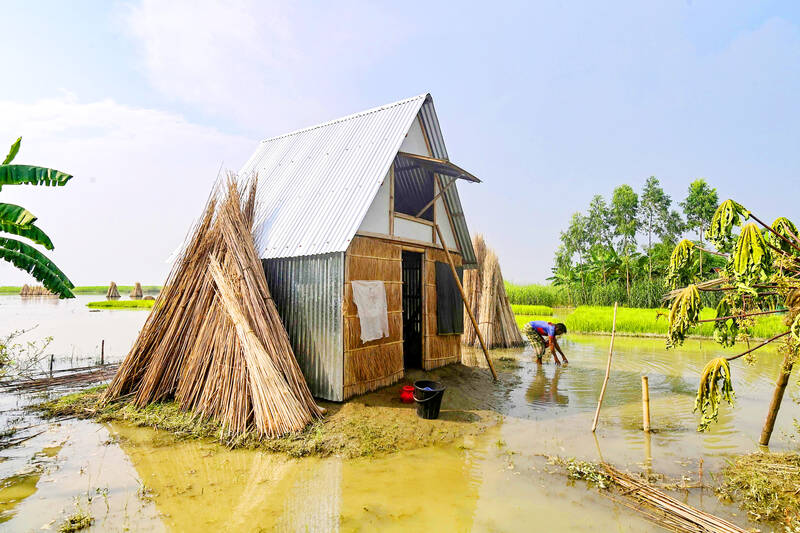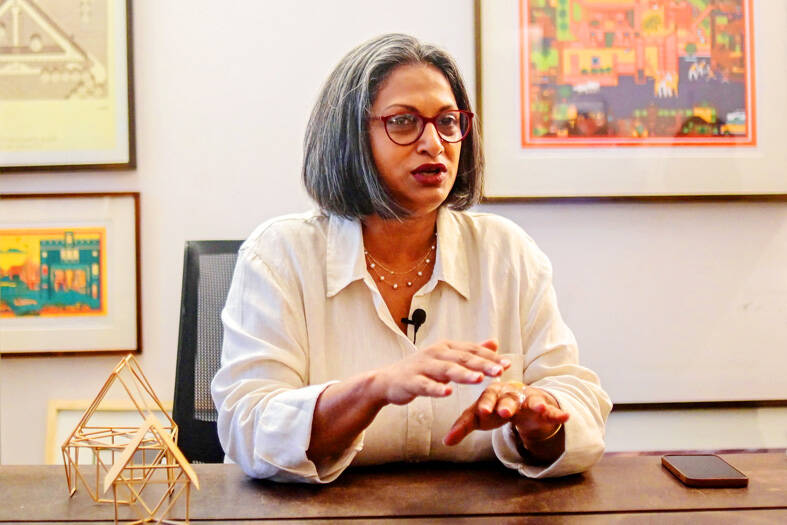An award-winning architect in Bangladesh, one of the nations most at risk from flooding driven by climate change, has developed an ingenious two-floor housing solution to help people survive what scientists warn is a growing threat.
This year, when the annual monsoon floodwaters swelled the country’s mighty Brahmaputra River, 40-year-old farmer Abu Sayeed did not have to abandon his home for the first time in his life — but merely climb up a ladder and wait out the waters.
The Khudi Bari, or “tiny house” — resilient homes made on bamboo stilts rising out of the floodwaters that are also easy to move to safer locations when needed — offer hope to millions.

Photo: AFP
“Khudi Bari has saved us,” said Sayeed, who like millions, lives on Bangladesh’s vast river floodplains because the fertile soil is good for the maize and chilli crops he grows.
“We did not leave ... we slept on the upper floor. I hope we will never have to flee our homes thanks to this house,” he said.
Bangladesh is listed as the seventh most vulnerable to extreme weather caused by climate change and rising sea levels, environmental rights organization Germanwatch says.

Photo: AFP
Much of Bangladesh is made up of deltas as the Himalayan rivers of the Ganges and Brahmaputra slowly wind through the low-lying country toward the sea.
With millions at risk, relocating people to higher ground is a near-impossible task.
“Fleeing your home during the floods is part of your life,” said Sayeed, from the northern village of Shildaha, where 17 prototype Khudi Bari houses have been built by Bangladeshi architect Marina Tabassum.
“Often, when the floodwater recedes, you come back to see that your goods were all stolen,” Sayeed said.
Scientists warn of the growing effects of climate change increasing the intensity of monsoon rains, and say that ice in the Himalayas is melting faster than ever before.
Last year, floods in Bangladesh’s northeastern Sylhet region were some of the worst on record, leaving millions stranded, while about 100 people were killed.
The government has built thousands of strongly built shelters for cyclones to withstand the severe storms that are also increasing in regularity.
However, although they do reduce fatalities, cyclone shelters are suitable only for hunkering down during the short span of a storm, and floods can swamp land for months.
Tabassum said that she worked to design a home for the “lowest cost possible for those in need,” using locally available materials by combining bamboo poles and metal sheeting.
Winner of the Aga Khan Award for architecture for her design of the Bait-ur-Rouf Mosque in Dhaka, and designer of the country’s Independence Monument, Tabassum developed prototype shelters to test them against flash floods and heavy winds.
“It can be assembled and disassembled very easily,” she said, calling it a “climate preparedness” project, with each house costing about US$450 to build, including labor.
“It’s a mobile modular system, so that’s why it can be moved from one location to another,” said Tabassum, the winner of Britain’s Soane Medal for architecture in 2021, including for her tiny house work.
Most of the Khudi Bari owners use their own solar panels, said Mohammad Azam Khan whose charity the National Development Programme joined with Tabassum’s organization to build the homes for farmers.
Arman Abedin, an associate of Tabassum, said every 4m-high house has two floors, each 9.3m2.
He said the architect has also used the Khudi Bari model to build a larger community center for Rohingya refugee women in the Bangladeshi camps.
Mohammad Kalu, 35, who lives in one of the Shildaha homes on stilts, said the design means people can easily adapt.
“If water rises to the chest or even cheek level, still we can stay in this house... We can go to the upper floor and cook with gas or firewood,” he said. “When the current is strong, we untie the tin walls and the water goes through our houses without any obstruction.”
Tabassum said she was partly influenced by the traditional wood homes of Bangladesh’s central Munshiganj, which are raised on stilts to allow floodwaters to pass under them during monsoon season.
Yet Sayeed said the design meant the new houses — with wooden stilts wrapped in metal covers — were far easier to move than traditional constructions.
“Now we don’t need to buy new materials when we disassemble the houses,” he said.
Tabassum is busy building more than a hundred Khudi Bari across Bangladesh to offer an example and inspiration for others.
Mohammad Jashim, who sells flat-pack wood homes in Munshiganj, said similar raised wooden home designs were proving popular.
“We are selling these homes all over the country,” he said. “They are environmentally friendly, can be easily relocated and can resist floods.”

GROWING OWINGS: While Luxembourg and China swapped the top three spots, the US continued to be the largest exposure for Taiwan for the 41st consecutive quarter The US remained the largest debtor nation to Taiwan’s banking sector for the 41st consecutive quarter at the end of September, after local banks’ exposure to the US market rose more than 2 percent from three months earlier, the central bank said. Exposure to the US increased to US$198.896 billion, up US$4.026 billion, or 2.07 percent, from US$194.87 billion in the previous quarter, data released by the central bank showed on Friday. Of the increase, about US$1.4 billion came from banks’ investments in securitized products and interbank loans in the US, while another US$2.6 billion stemmed from trust assets, including mutual funds,

AI TALENT: No financial details were released about the deal, in which top Groq executives, including its CEO, would join Nvidia to help advance the technology Nvidia Corp has agreed to a licensing deal with artificial intelligence (AI) start-up Groq, furthering its investments in companies connected to the AI boom and gaining the right to add a new type of technology to its products. The world’s largest publicly traded company has paid for the right to use Groq’s technology and is to integrate its chip design into future products. Some of the start-up’s executives are leaving to join Nvidia to help with that effort, the companies said. Groq would continue as an independent company with a new chief executive, it said on Wednesday in a post on its Web

JOINT EFFORTS: MediaTek would partner with Denso to develop custom chips to support the car-part specialist company’s driver-assist systems in an expanding market MediaTek Inc (聯發科), the world’s largest mobile phone chip designer, yesterday said it is working closely with Japan’s Denso Corp to build a custom automotive system-on-chip (SoC) solution tailored for advanced driver-assistance systems and cockpit systems, adding another customer to its new application-specific IC (ASIC) business. This effort merges Denso’s automotive-grade safety expertise and deep vehicle integration with MediaTek’s technologies cultivated through the development of Media- Tek’s Dimensity AX, leveraging efficient, high-performance SoCs and artificial intelligence (AI) capabilities to offer a scalable, production-ready platform for next-generation driver assistance, the company said in a statement yesterday. “Through this collaboration, we are bringing two

Even as the US is embarked on a bitter rivalry with China over the deployment of artificial intelligence (AI), Chinese technology is quietly making inroads into the US market. Despite considerable geopolitical tensions, Chinese open-source AI models are winning over a growing number of programmers and companies in the US. These are different from the closed generative AI models that have become household names — ChatGPT-maker OpenAI or Google’s Gemini — whose inner workings are fiercely protected. In contrast, “open” models offered by many Chinese rivals, from Alibaba (阿里巴巴) to DeepSeek (深度求索), allow programmers to customize parts of the software to suit their